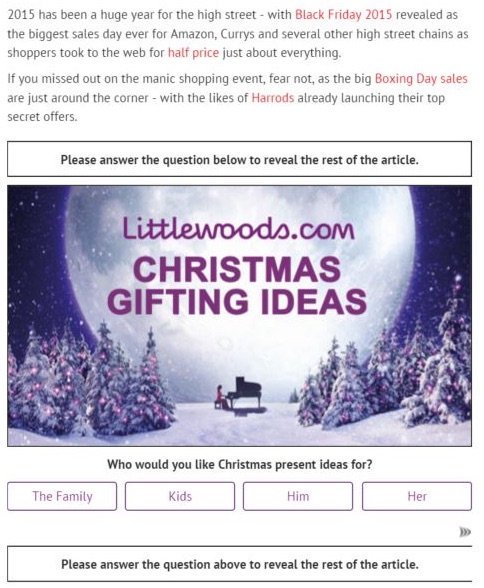
If you want to read a full Ziff Davis article, soon you’re going to have to answer a question first.
After running successful test campaigns with Vodafone this summer, publisher Ziff Davis is using technology from Rezonence to help increase its digital ad revenue, joining publishers like Trinity Mirror, the BBC, City AM and Time Inc. The publisher will begin using Rezonence’s ad unit, called FreeWall, on mobile and desktop across Ziff Davis’ portfolio in the U.K. before wider global roll-out.
Audiences will see the ad units appear on sites, such as PC Mag, IGN and Ask Men, usually below the fold after the third paragraph, which will ask reader to answer a question in order to finish reading the article.
“The technology gives value to the editorial content that’s being produced,” Adam Hopkinson, international commercial director at Ziff Davis told Digiday. “It helps to create that channel effect where that content is appearing. If there are metrics that demonstrate people are engaging with editorial on that platform, then it’s a good thing for the publisher and the advertiser.”
Diminishing digital revenues, platforms wielding more control over publishers, and growing numbers of people turning on ad blockers are all adding to the number of challenges for publishers.
FreeWall gets its name from the fact that it tries to deliver the best of both worlds: It is open to a broad audience (free model) and the ad is being seen by engaged readers (paywall). In other words, the impression is not wasted on non-human traffic and is not positioned where readers can’t see it. The ads then return a higher investment on the advertiser’s ad dollars. Publishers can boost digital revenue through higher audience engagement and gain more insight and first-party data.
“They can stop writing clickbait headlines and focus more on what they want to do: write longer-form content,” said Tim Greatrex, founding director of Rezonence.

It works on a cost-per-engagement model rather than CPM or CTR that display ads are traditionally sold on and charges between 10 and 50 pence each time a survey is completed. There is also space for secondary display ads to run at the end of the article which, according to the company’s testing, has been getting approximately 5 percent CTR, compared to DoubleClick’s industry benchmarks, which settled at around 0.1 percent.
Other companies, like Qriously, work on a similar cost-per-engagement model by delivering units that people need to interact with. But there’s a problem with more interactive units. “Advertisers and agencies are pushing for more interactivity as a metric for engagement,” said Hopkinson, “which means bigger ad units that take up more space and load pages slower, so people turn to ad blockers. How are you supposed to win?”
FreeWall ads are capped at one per site, per month, so they are, in theory, more sustainable and scalable. Rezonence’s units were built to be lightweight in compliance with the IAB’s LEAN guidelines for more effective, faster loading ads.
Ziff Davis’ men’s lifestyle title Ask Men, which has a U.K. audience of 730,000, according to comScore, (by comparison, Conde Nast’s men’s lifestyle title GQ reached 607,000 for the same month) has a tech-savvy audience that is particularly knowledgeable about ad blockers — a full 25 percent of its users are turning to them. “It is a problem, and it does exist. It might not be as bad as everybody is worrying about,” said Hopkinson. Even so, he adds that the U.K. should take the lead from markets like Germany, where publishers are taking legal action against ad-blocking companies.
Ad blocking on mobile is much less of a problem, but Hopkinson said it is creeping up.
“What has always bothered me when you read about people’s mobile ad strategies is that they seem really simple; they just consider mobile as another screen,” he said. “We’re spending a lot of time testing the reasonable to the near-fetched ideas of what can be done with this and mobile ads. No one has really got it yet, including us.”
More in Media

Why some publishers aren’t ready to monetize generative AI chatbots with ads yet
Monetization of generative AI chatbot experiences is slow going. Some publishing execs said they’re not ready to add advertising to these products until they scale or can build a subscription model first.

Media Briefing: Publishers who bet on events and franchises this year are reaping the rewards
Tentpole events and franchises are helping publishers lock in advertising revenue.

With Firefly Image 3, Adobe aims to integrate more AI tools for various apps
New tools let people make images in seconds, create image backgrounds, replacing parts of an image and use reference images to create with AI.





